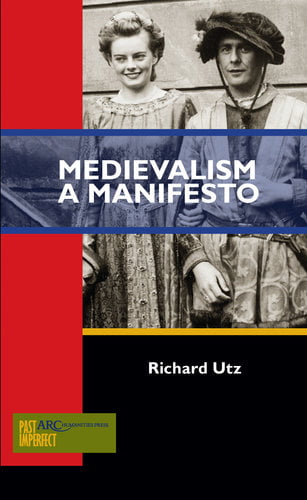Review: Richard Utz, Medievalism: A Manifesto (Kalamazoo and Bradford: ARC Humanities Press, 2017). 95 pages, $15.00/£11.99. https://mip-archumanitiespress.org/products/m-77101-116111-24-8211/.
 Over the past generation, the humanities have been changing immensely—both due to pressures from within as well as from without. Long gone are the days, if they ever really existed in the first place, of the cloistered ivory tower academic, whose sole job was to dutifully retreat from the world into a quasi-monastic world of study, commentary, and teaching the occasional novice.
Over the past generation, the humanities have been changing immensely—both due to pressures from within as well as from without. Long gone are the days, if they ever really existed in the first place, of the cloistered ivory tower academic, whose sole job was to dutifully retreat from the world into a quasi-monastic world of study, commentary, and teaching the occasional novice.
And good riddance, too. Many academics have chafed at the increasing pressures from government initiatives and University directives to increase their public engagement. But a new crop of scholars have taken on this mantle with enthusiasm. And while it may not necessarily be where the public might expect this to arise, several scholars in the dusty-seeming discipline of medieval studies have been leading the charge.
It is because of this context that Medievalism: A Manifesto by Richard Utz, part of the Past Imperfect Series at ARC Humanities Press, is so important. It offers an affordable, much-needed call-to-arms to those medievalists still on the fence about working for, among, and with the public. This book—especially its final chapter, which comprises the real “manifesto” of the volume—should be required reading for every medieval studies Ph.D., and taped to the door of many a public history professor. For some, many of its ideas will seem obvious, while for others they may offer a profound challenge; but this fact says more about the current state of the professoriate than about this text.
Like every good manifesto, this little volume is stuffed with heretical ideas. The first chapter, “What’s Love Got To Do With It?: The Middle Ages, Ourselves” is a case study of pulling down the sacred cow of some historians: total objectivity. Utz weaves together the story of his parents and his own coming to love the Middle Ages with a brief overview of the state of the field. The heretical idea here is that no medievalist, no matter what some may profess, is cut off from broader cultural ideas about the Middle Ages—in short, that they can never, nor should they, truly remove themselves (and their passions) from their work.
The second sacred cow that Utz attacks, in Chapter 2, is that of unquestionable academic authority. Medieval studies, as a discipline, began very much as an amateur affair. But since its nineteenth-century beginnings, the field has rent itself from, and placed itself above, the “mere” amateur love of medievalia. This professionalization was a good, perhaps even necessary thing. But the consequence is a current world where most medievalists only talk to other medievalists, writing in high-status but low-readership journals in an impenetrable language of their own creation. This system is not just unsustainable, it’s morally wrong. Scholars have an obligation to not just to uncover new knowledge, but disseminate it to the best of their ability.
The next three chapters form a sort of second part of the book, each marked out as an “intervention”. Each intervention (in Eastern Bavaria, Atlanta, and within the world of religion) outlines a different plot of fertile soil for the interested public medievalist. In all of these locations, there are ready ways in which medievalists can, and should, engage with the public to positive effect, to present a more complex and nuanced image of the past and its relationship with the present and future.
The final chapter, as mentioned previously, is the best of a good bunch (probably because it is the most direct and concise). In it, Utz presents six brief manifestos for the public medievalist. They, boiled to their essences, are:
- Medievalists are not so different from other lovers of the Middle Ages;
- The best work in medieval studies recognizes the history of the public’s engagement with the topic;
- Medievalists should tear down the barriers to understanding our subjects, and write not just for our colleagues, but for everyone;
- Academic hiring and promotion committees should recognize, reward, and incentivize good public engagement;
- The amateur interest in the Middle Ages in our culture is a blessing, not a curse; medievalists should embrace it, use it, and learn from it; and
- Traditional academia has its place, but the world needs a new kind of medievalist—one unafraid to engage with reception, popular debates, the media, and accessibility.
Taken together, these form a powerful call for medievalists to go forth and engage with the broader public, to create, in his words, “a more truly co-disciplinary, inclusive, democratic and humanistic engagement with what we call, for better or worse, the Middle Ages” (87). While the rest of the book should not be skipped, if you must read only one chapter, read this one.
From the above, it should be obvious that I feel strongly that this book is not just good, but necessary. That said, it does slip up in a few places—not least occasionally falling victim to a problem of “do as I say, not as I do”. To its extreme credit, ARC Humanities Press has offered it for $15/£12 (and as an e-book for less) which lowers one barrier to entry considerably. But some of the other barriers remain. For or example, Utz rightly castigates other medievalists for speaking only into their particular echo chambers in a language needlessly riddled with convoluted constructions, opaque jargon, and assumptions of prior knowledge. But, especially in the first two chapters, I found that Utz employed some of this very style, which left me occasionally scratching my head. To his credit, Utz admits its seductive power over him. Speaking of the BABEL group, he admits:
their demiurgic polysyllabicity, which I personally find exhilarating, may present an insurmountable barrier for those amateurs who have never called the “ruined towers of the post-historical university” their home” (22).
Yes, this is a book by a medievalist and for medievalists. And yes, in order to be “taken seriously” among some academics, there may be a need to flex one’s proverbial polysyllabic muscles, and simply name-drop all the academics a reader “should be expected to have read” (pity the poor master’s student who picks up this book). But if one is to increase accessibility through increased comprehensibility, the work, as they say, begins at home. I do not fault Utz for writing a book that shouts into the very echo chambers that he criticizes. It is there that this message needs to be heard. But I do hope that his next monograph is written for a wider audience.
All that being said, it remains a worthwhile book, with messages that deserve to be read and repeated. While it does not mark the beginning of the effort towards vigorous public engagement among medievalists, it can be hoped that this volume might consider more of them to join the cause.
Disclosure: This reviewer received a free copy of the book in exchange for this review. Professor Utz adapted a chapter from this book for The Public Medievalist.



Comments are closed.